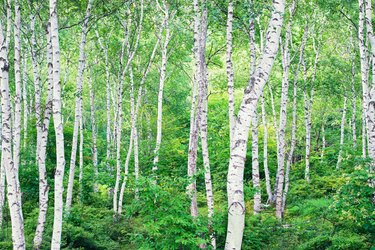
The silver birch tree (Betula pendula) is also known as white birch, and it is native to the European continent. Silver birch is a quick-growing, deciduous tree that can reach heights of 65 feet. Betula pendula is grown for its attractive, non-peeling bark, which is white and turns black over time, its flowers, which appear in April and May, and its reputation for attracting wildlife. If you are fortunate enough to have these trees in your lawn or garden, beware of some of the most common problems and silver birch diseases associated with the species.
1. Birch Dieback Disease
Video of the Day
Betula pendula is susceptible to dieback, a disease that causes damage to several species of birch trees. The fungi Anisogramma virgultorum, Discula betulina and Marssonina betulae cause dieback in silver birch trees. Birch trees show sign of dieback infection between five and 10 years after being planted, with branches of the crown steadily deteriorating, defoliating and eventually dying. Prune and dispose of dead branches on your tree to stop the spread of this silver birch disease. Create a solution of 10 parts water to 1 part bleach and wipe your loppers with it to sterilize the tool before and after pruning the ailing tree to prevent the spread of this silver birch disease.
Video of the Day
2. Anthracnose Fungal Disease
Anthracnose is a disease that affects many birch trees, including Betula pendula. Anthracnose is a disease brought on by the fungus species Glocosporium betularum, and it causes irregular dead areas on leaf margins. In more serious cases of anthracnose, the entire leaf can be engulfed in brown spots with black margins, which can spread to young shoots and small twigs, causing decay.
3. Marssonia Leaf Spot
Marssonia leaf spot is a disease that affects European white birch and only a few other tree species. Infected trees exhibit symptoms such as brown blotches or spots on the leaves, severe defoliation, a weakened immune system and stunted leaf or bark growth. Marssonia leaf spot typically appears on the lower branches first during summer or early fall, and the disease spreads upwards through the rest of the year. The fungus that causes Marssonia leaf spot overwinters in dead or infected foliage, and removal of these branches, twigs and leaves, as well as proper sanitation practices, are the only way to rid trees of this disease.
4. Conks – Incurable Silver Birch Diseases
Silver birch trees are susceptible to an incurable group of wood rots known as shelf fungi, in tribute to their hard, shelf-like reproductive structures, known as "conks," that form on the trunks of infected trees. Conks known to infect Betula pendula include artist's conks, tinder conks, chaga conks and birch conks, slowly breaking down dead wood and growing outward in rings. Conks cause the wood of silver birch trees to decay, with some infected specimens showing openings or hollows in the trunk or branches while others show no external symptoms at all, with trees having been known to rot from the inside out.
- Plants for a Future: Betula pendula - Roth.
- Oklahoma State University Cooperative Extension: Anthracnose and Other Common Leaf Diseases of Deciduous Shade Trees
- Alaska Plant Profile: Conks/Shelf Fungi
- University of Illinois Extension: Selecting Trees for Your Home - Wood Rots and Decays
- STIHL Power Tools: Encyclopedia of Trees - Silver Birch (Possible Types of Damage)
- University of Illinois Extension: Selecting Trees for Your Home - Marssonia Leaf Spots and Blights